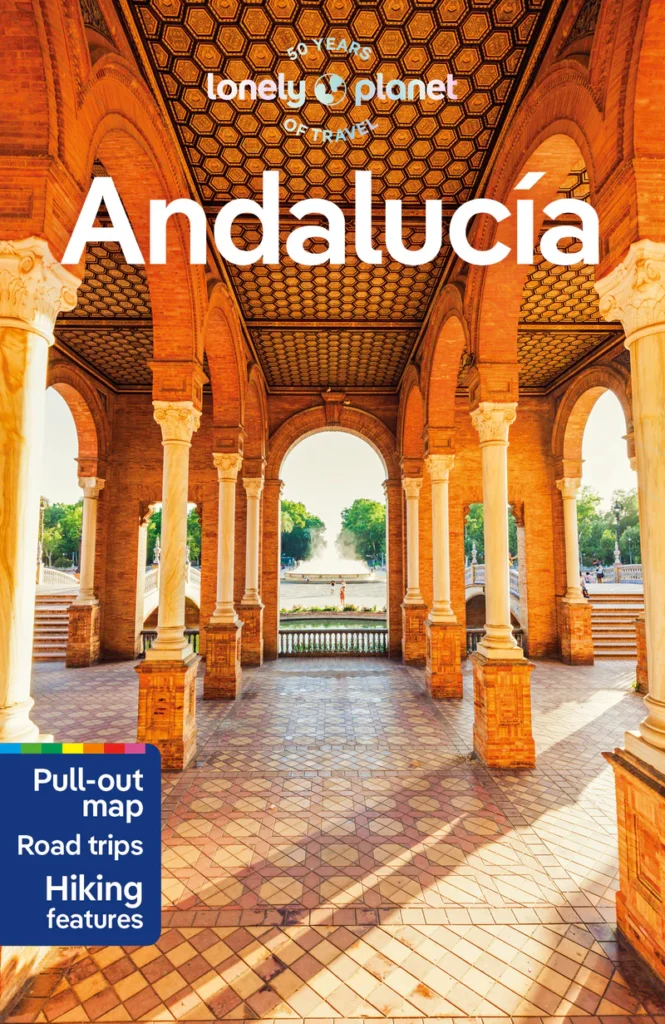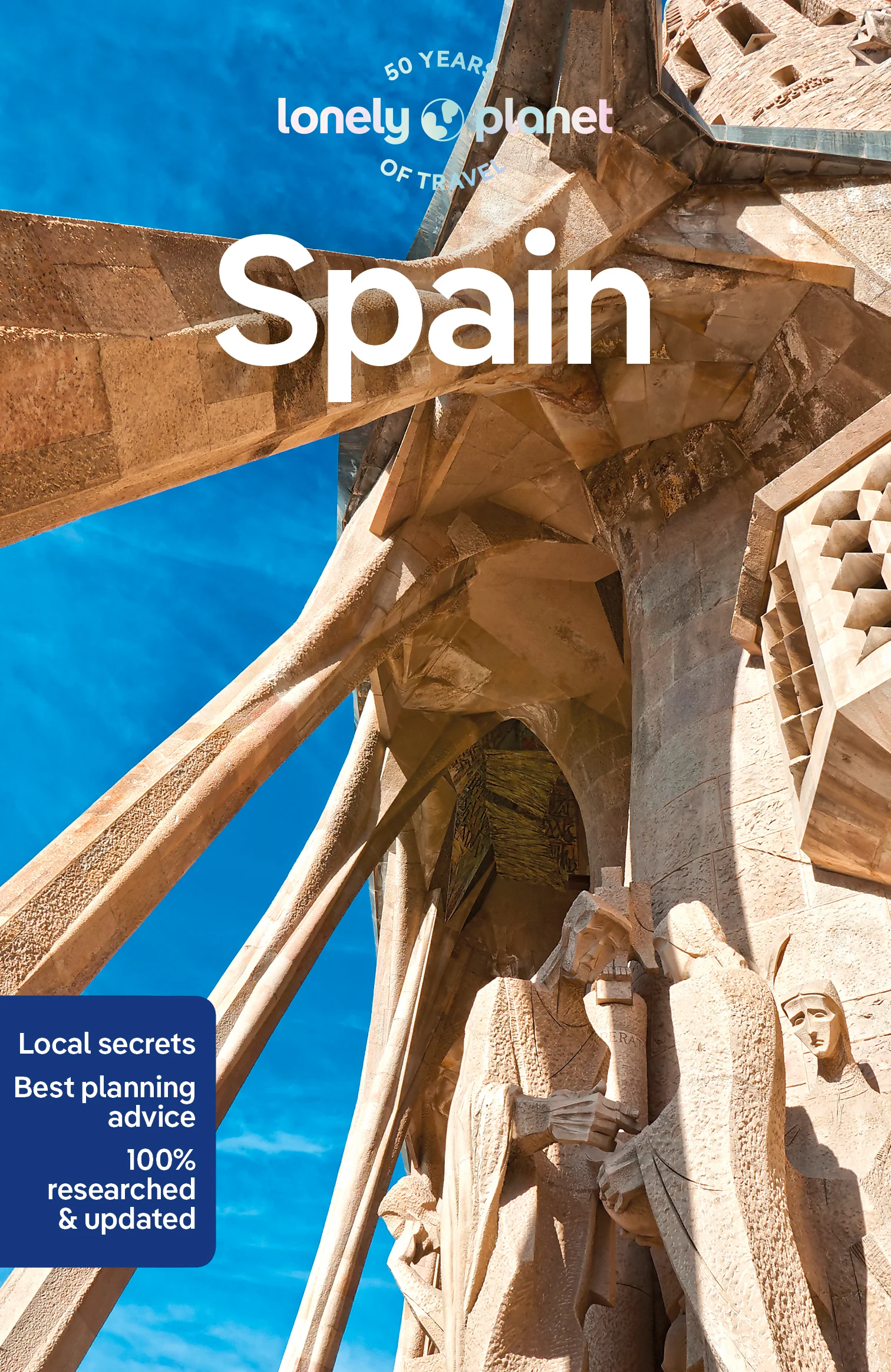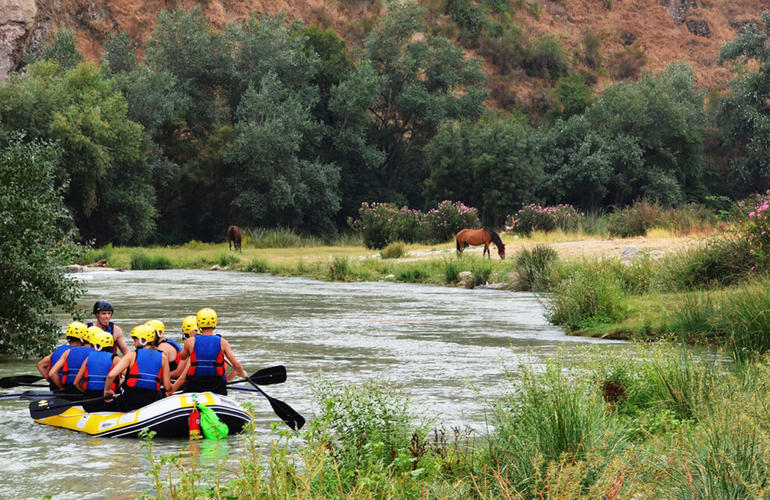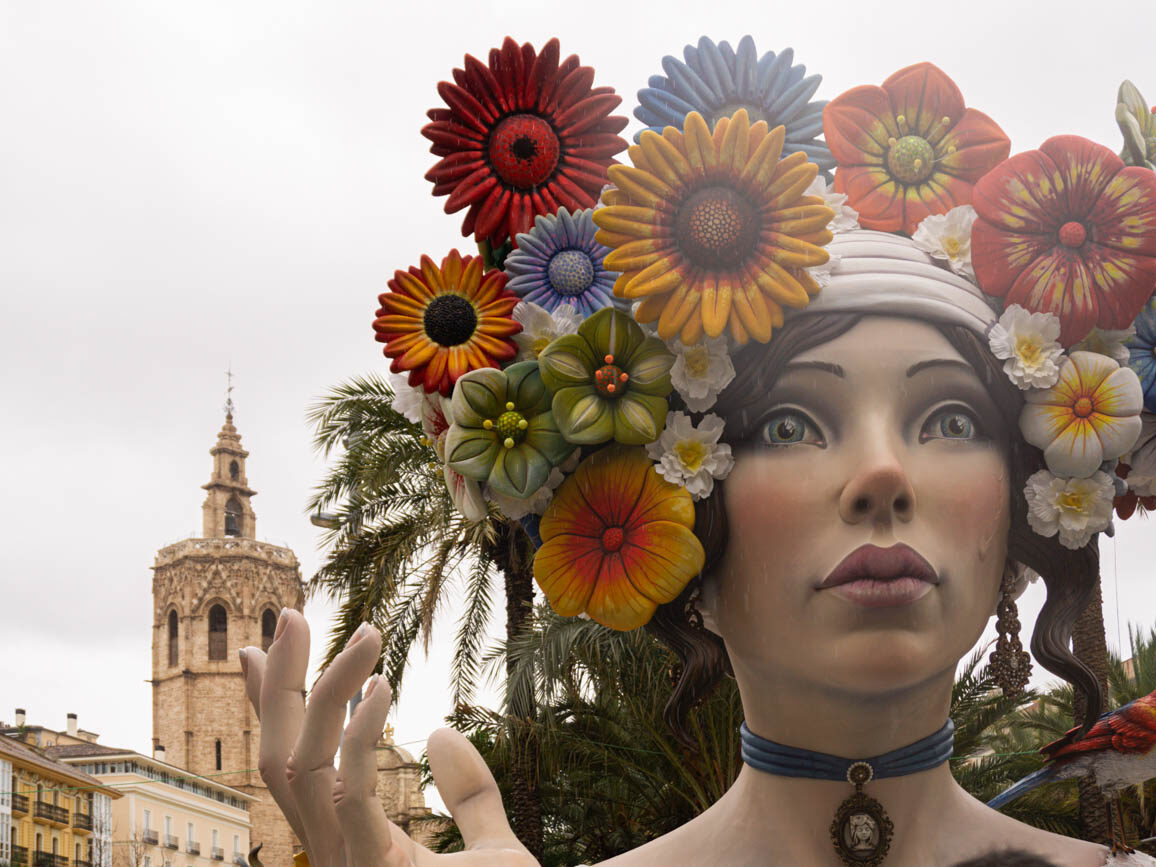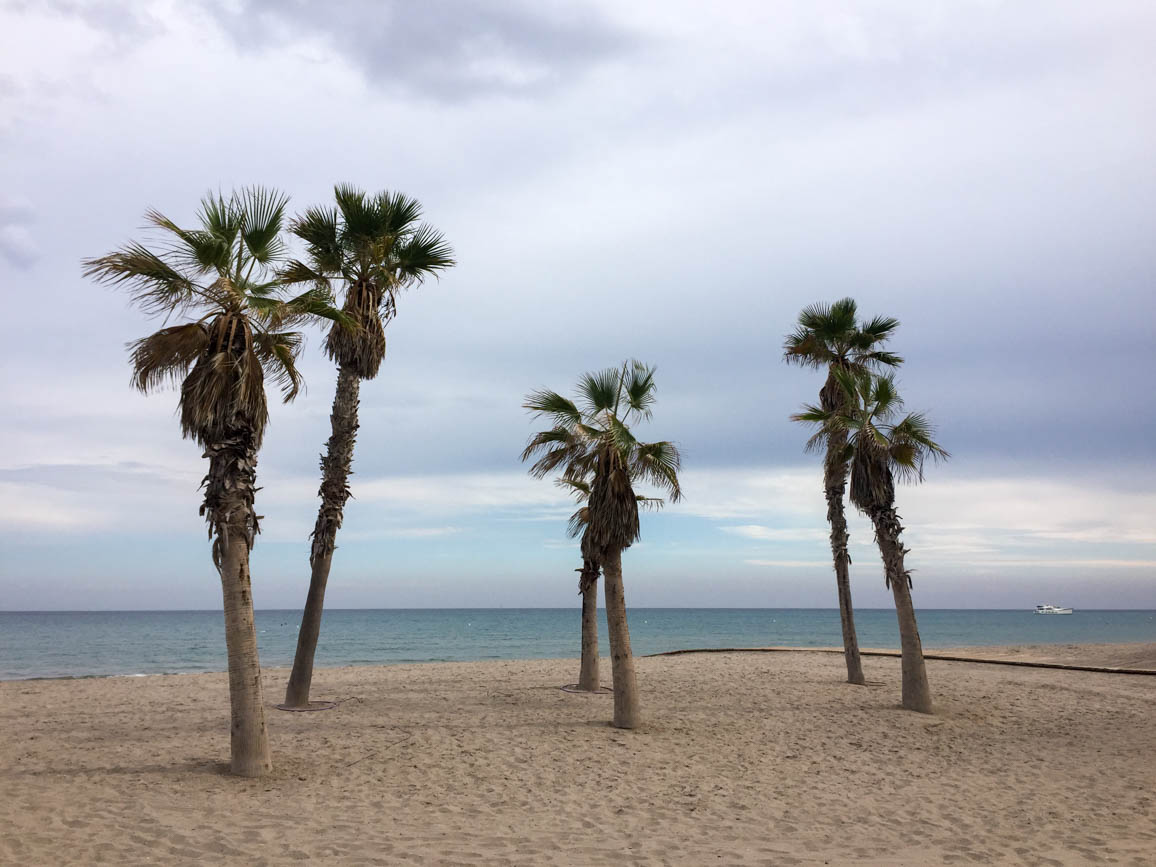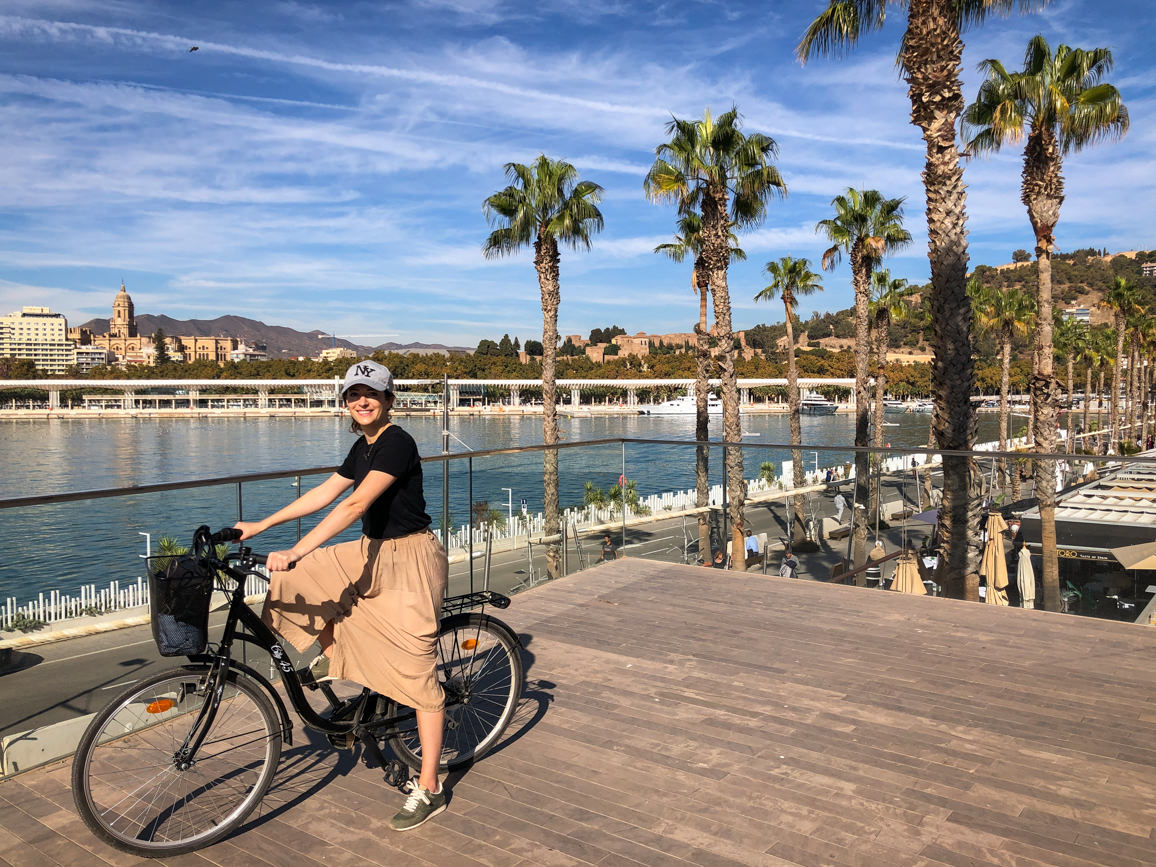
Top things to do in Málaga, the capital of Costa del Sol (+ map)
If you’re heading to Málaga (Spain) soon, this travel guide will help you plan your visit: from what to see and the top things to do, to where to eat and stay. I bet you’ll love this friendly Spanish city located on the Costa del Sol as much as I do, and will be longing to come back for more in no time. Ready to start exploring?
***
Disclaimer:
- I’ve visited Málaga various times over the years, the last one being in January 2024. This updated post is a compilation of prior trips and reflects the latest information available.
- Please note that this post includes some affiliate links. This means that, at no additional cost for you, I earn a commission if you make a purchase. In case you have any question about the companies advertised here or my status as an affiliate, please do not hesitate to contact me.
***
By the way, throughout my trips to Málaga I’ve used these travel guidebooks below by Anaya Touring and Lonely Planet to plan accordingly and make the most of the experience. I hope you’ll find them helpful too!
Good to know before visiting Málaga

Where is Malaga?
The southern region of Andalusia (or Andalucía) encompasses some of the most popular destinations in Spain, including Sevilla or Granada.
Located along a sunny coastline stretch known as Costa del Sol, Málaga is the capital and largest city in this area with almost 600,000 inhabitants. It is also the second largest city in the Andalusia region.
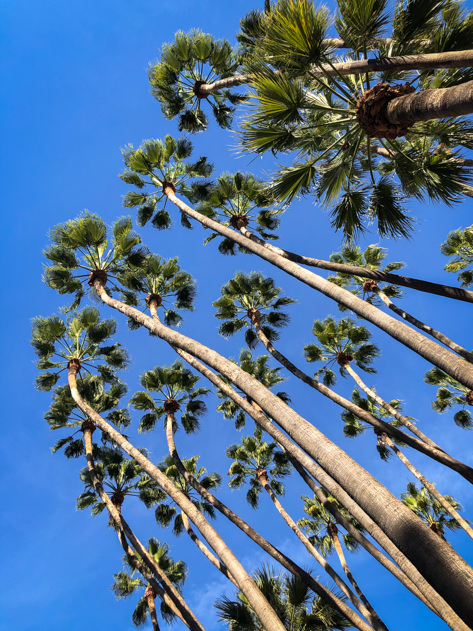
When is the best time to visit Málaga?
The Malaga weather is usually warm and nice all year round. However, to avoid the crowds and the scorching heat, do your best to visit during the shoulder season, i.e. during the spring from March til May or in the fall between September and November.
In case you would like to immerse yourself in a true local cultural experience, check out the section on the main celebrations (or ‘fiestas‘) happening in the coastal city of Málaga throughout the year. Having said that, bear in mind that prices will probably increase during those dates.
Do you like my content? Subscribe to my newsletter to stay tuned.
How to visit Malaga on a budget
Consider purchasing the Malaga – Costa del Sol Sightseeing Pass during your trip. Depending on your budget, you can pick one of these simple money-saving options.
On the one hand, with the Day Pass (starting at 32 EUR per day), you can see an unlimited number of attractions over one, two or three days.
On the other hand, the Flex Pass (at 14 EUR per attraction) allows you to visit any two, three or four attractions from 16 options over 60 days.
Things to do and see in Málaga
Malaga is an ancient city with a long history dating back more than 3,000 years. Over the centuries, it was ruled by Phoenicians, Romans, Muslims and then the Catholic Monarchs. Since the 1960s, Malaga and the Costa del Sol became an important tourist destination given their pleasant weather all year round.
From renowned museums, to Moorish and Baroque architecture or idyllic beaches lying by the Mediterranean Sea, the coastal city of Malaga truly has it all. For your ease of reference, I’ve listed them in different categories:
- top sights;
- best museums;
- parks, gardens and beaches;
- other attractions off the beaten track;
- local celebrations.

Ready to start exploring the top attractions you can find in Málaga?
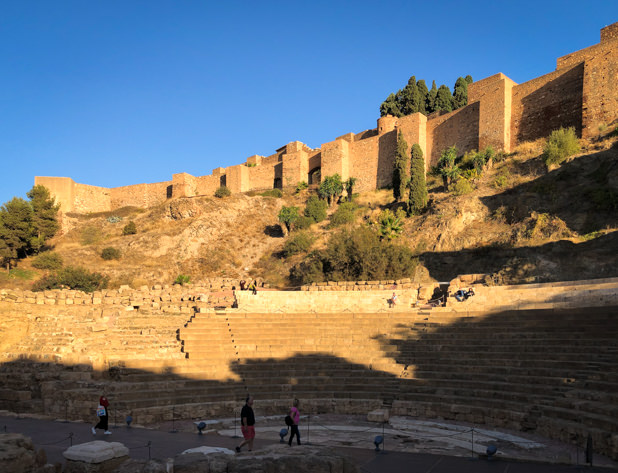
Top sights in Málaga
Visiting a major city can feel overwhelming, especially if it’s your first time there. To help you out, these are the top sights I would recommend checking out in Málaga:
- Alcazaba: strategically located on a hill overlooking the Mediterranean Sea, this Muslim citadel was built between 1057 and 1063 by King Badis of Granada. Although it was originally erected as a military and defensive enclave, it underwent multiple reconstructions over the centuries. Currently, you can visit the elegant palaces, patios, gardens and ponds of the Alcazaba while admiring the archaeological remains in the museum (Museo Arqueológico).
- Roman Theatre (Teatro Romano): this is the main preserved vestige of the Roman presence in the city. It was built in the early years of the 1st century AD and lost its original use around the 3rd century. It is currently used for classical theater performances and lies next to the Alcazaba.
- Cathedral (Catedral de la Encarnación de Málaga): this imposing temple can be seen from anywhere in the city. Nicknamed La Manquita (“one-armed lady”) because one of its towers was curiously left unbuilt, it took five centuries to build the cathedral. Hence, this religious building features different architectural styles from Gothic to Renaissance or Baroque. Inside the cathedral you will find a museum, and next to it lies the Episcopal palace (Centro Cultural Fundación Unicaja de Málaga) in Plaza del Obispo. Should you want to explore other churches throughout this Spanish city, here are some ideas: santuario de Nuestra Señora de la Victoria, iglesia del Sagrario, iglesia parroquial de Santiago, iglesia del Santo Cristo de la Salud, iglesia de los Santos Mártires, iglesia de San Juan, iglesia de San Felipe Neri or parroquia de San Pedro Apóstol.
- Calle Larios: formally known as Calle del Marqués del Larios, it remains the most emblematic street in Malaga since its opening in 1891. It connects two major squares (Plaza de la Constitución and Plaza de la Marina). Along this pleasant pedestrian promenade, locals and visitors can hop from shops to various bars and restaurants. There is also a monument dedicated to the second Marquis of Larios, Don Manuel Domingo Larios y Larios.
For additional information about historic monuments in Málaga, you can check out this local website. Down below you will find a section covering attractions off the beaten track too.
Take a look at these travel guides!
9 things to do in Rio de Janeiro: the ultimate travel guide & map
Granada travel guide: best things to see and do in 24 hours
Mexico travel guide: my 10-day itinerary
Stockholm travel guide (+ map)
Top things to do in Valencia: travel guide + map

Best museums in Malaga Spain
Culture radiates strongly throughout Málaga. In recent years, the city has deeply transformed into a cultural hub thanks to a number of renowned museums, including the following:
- Picasso Museum Malaga (Museo Picasso): this is definitely one of the top things to do in Málaga. Spanish artist Pablo Picasso was born in Málaga in 1881 and lived there for ten years before moving to La Coruña, Barcelona, Madrid and Paris. As a tribute to his hometown, the elegant museum located in the Palacio de Buenavista houses more than 200 works by this influential figure, ranging from paintings and sculptures to ceramics. These cover the different artistic stages of the famous painter. The single ticket costs €12, includes an audio guide and will give you access to both the permanent and temporary exhibitions. By the way, I recommend you book well in advance! In the basement of the Picasso Museum, you will find Phoenician and Roman remains of the former city of Malaka. You can also grab a bite in the cafeteria. Should you be interested in learning more about Picasso, head to his childhood home now turned into a museum next to Plaza de la Merced (Museo Casa Natal Picasso). Steps away, you can actually snap a selfie with his statue!
- Museo Carmen Thyssen: inaugurated in 2011, the patron Carmen Thyssen has lent the city of Malaga a truly important collection of Spanish paintings from the 19th and early 20th centuries with works by Zurbarán, Sorolla, Zuloaga or Regoyos. In case you travel to Madrid, I highly encourage you to visit the Thyssen-Bornemisza Museum, one of the most renowned galleries in the country.
- Centre Pompidou Málaga: established in 2015 as the first branch of the famous modern art museum outside of France, it is located near Malaga’s port in Muelle Uno. After going through the colorful cube-shaped entrance, you will admire works by major artists such as Picasso, Miró, Frida Kahlo or Giacometti. Get your tickets here.
- Museo de Málaga: originally a custom house, this museum features more than 15,000 pieces including archaeological objects and artistic works in the emblematic Palacio de la Aduana. Don’t forget to enjoy the view from the rooftop cafeteria!
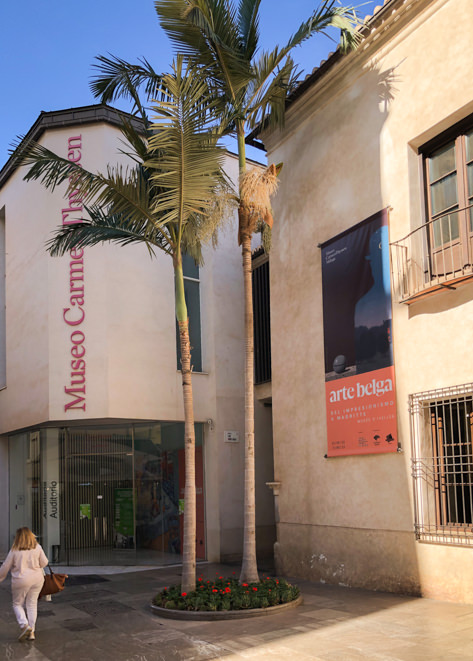
In addition to the abovementioned museums, here are some other art galleries you can visit in Málaga: Centro de Arte Contemporáneo, Museo Revello de Toro, Museo Unicaja de Artes y Costumbres Populares or Museo del Arte Cofrade – Semana Santa. Last but not least, stay tuned for the upcoming opening of the Sephardic Museum of Malaga, right behind the Picasso Museum. As you can see, Málaga is home to some important museums, so you will have plenty of options if you’re an art savvy!
Similarly, the coastal city of Málaga hosts a number of cultural venues including theaters and cultural centers such as Ateneo de Málaga, Teatro Cervantes, Teatro Echegaray or Teatro del Soho CaixaBank (owned by Hollywood actor Antonio Banderas).
Finally, the Malaga Film Festival (Festival de Málaga), happening yearly around the month of March, disseminates and promotes Spanish cinematography.

Parks, gardens and beaches
The city of Malaga features a variety of locations where you can enjoy outdoor activities and the sunny weather all year round.
In terms of parks and gardens, the main ones are the following:
- Alameda Principal: although the central part of the Alameda was transformed into a wide road in the 20th century, this walk flanked by centuries-old ficus, Indian banana trees and elegant, bourgeois buildings lies at the mouth of the Guadalmedina River.
- Jardín Botánico Histórico La Concepción: this oasis located in the north of the city houses thousands of tropical plants and species.
- Jardín del Retiro: even though it lies way off the beaten track, this botanical and ornithological garden goes back more than 350 years. Encompassing English, French, Italian and Moroccan styles, it houses 400 species of animals as well as a 200-year-old elm tree known as El Olmo.
- Jardines de Picasso: this park dedicated to the famous Spanish painter is located at the end of Avenida de Andalucía. It houses a monument to Picasso as well as beautiful vegetation.
- Palmeral de las Sorpresas: located along the pier near the port (Muelle Uno), this modern promenade with palm trees and public art features a large pergola that runs almost its entire length.
- Parque Forestal de Gibralfaro: this forest park linking the Alcazaba and the Gibralfaro Castle represents the green lung of Málaga thanks to its lush vegetation. Its proximity to the city center makes it very easy to access. The park offers a wide network of trails more than 2 km long, and of varying difficulty.
- Paseo del Parque or Parque de Málaga: this garden walk near the Alameda and the Mediterranean Sea is home to a variety of plants. It also hides some delicate fountains (fuente de Génova, fuente de las Tres Gracias, fuente de Carlos V) and monuments dedicated to prominent figures in Spanish history such as Cánovas del Castillo. The nearby gardens (Jardines de Pedro Luis Alonso and Jardines de Puerta Oscura) offer a great view of the imposing Alcazaba right behind them.
You can check out this local website for more information about the parks and gardens in Malaga.
When it comes to the beaches, it comes as no surprise that Málaga offers a wide array of them given its strategic location by the sea. Hitting the beach is actually one of the top things to do in Málaga!
The most famous downtown beach is Playa de la Malagueta, a few steps away from the city center.
Should you head east or west, you’ll find great beaches along the coastline.
Some worth mentioning include Playa de la Caleta, Playa de Pedregalejo (ideal for kids since the area is enclosed like in a bay), El Palo, El Dedo, El Peñón del Cuervo or La Araña.
Feeling adventurous? Check out these Manawa outdoor activities in Málaga.
Rafting Excursion on the Genil River, Malaga
Quad biking excursion from Mijas, near Malaga
Vía Ferrata Caminito del Rey, Malaga
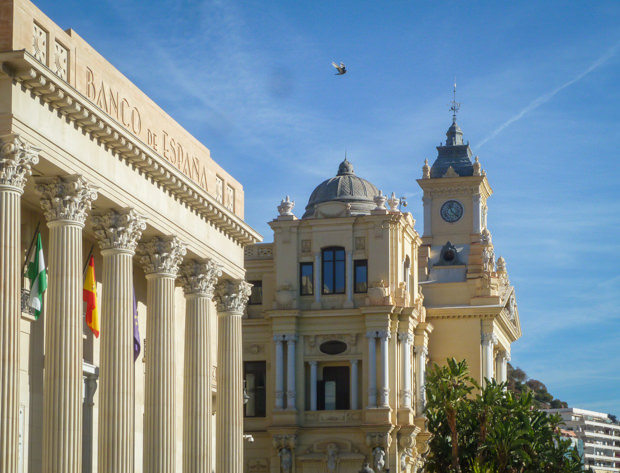
Other attractions off the beaten track
The Spanish city of Málaga truly has it all, from world-class museums to historic monuments and fantastic beaches. In case you feel like exploring less obvious sights, here are some of my suggestions:
- Bullring (Plaza de Toros de la Malagueta): this iconic landmark was inaugurated in 1876. With a capacity of over 14,000 people, this bullring has housed bullfights, festivals, concerts and cultural events. If you want to live the full experience, get a ticket for a bullfight. Otherwise, you may access part of the bullring during temporary exhibitions in its cultural center (Centro Cultural La Malagueta).
- City Hall (Ayuntamiento): located north of Paseo del Parque, the new town hall was built between 1911 and 1919 following a neo-baroque design. The interior houses an interesting artistic heritage with works by local artists from the 19th and 20th centuries.
- Gibralfaro castle (Castillo de Gibralfaro): this fortress remnant of Moorish rule overlooking the city of Málaga offers a breathtaking, panoramic view. It was built between 756 and 788 AD, but was rebuilt and acquired its final form in the Nasrid period around the 14th and 15th centuries. The castle was used as a military garrison, coastal watch and prison over the years. You can also visit the Interpretation Center within the premises, hike around the forest park surrounding the fortress or stop by the magnificent hotel (Parador de Málaga Gibralfaro).
- Hammam Al Andalus: relax in these Arab baths in Malaga while awakening your senses with water, massages and rituals. A true hammam experience to take a break during your stay!
- Malaga’s English cemetery (Cementerio Municipal inglés de Málaga): established as the first protestant cemetery on the Spanish peninsula, this peaceful corner of the Costa del Sol opened in 1831 to accommodate protestants who could not be buried elsewhere.
- National Bank (Banco de España): it was built between 1933 and 1936 and has a neoclassical appearance.
- Old Post Office building (antiguo edificio de Correos): projected in 1916 by Teodoro de Anasagasti, it now houses the rectorate of the University of Malaga (Rectorado).
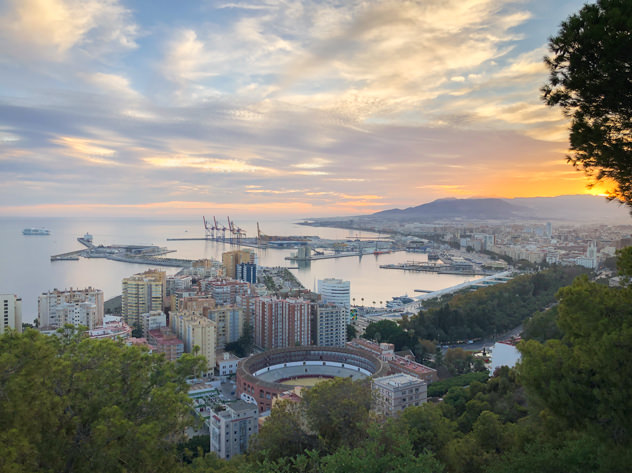
Last but not least, you should enjoy the panoramic of the city of Málaga from one of its viewpoints (or miradores in Spanish), including the following:
- AC Hotel Malaga Palacio: head to the ATICO Bar and Restaurant to admire unforgettable views of Malaga from the rooftop.
- El Morlaco: lying between the beaches of La Caleta and Pedregalejo, this forest park offers two viewpoints (Mirador Este and Mirador Sur).
- Ermita del Monte Calvario: from this old hermitage located at the top of a mountain you can see scenic views of both the city and the African coastline on clear days. The best time to visit is on Friday afternoon, when the brotherhood opens the gate and you can access up to the small square.
- Parador de Gibralfaro: this hotel is located on top of a hill near the homonymous castle. Either if you’re sleeping there or just stopping by, make sure to soak up the views (you can even see the bullfights that take place in the Plaza de Toros de La Malagueta from there!). Other nearby viewpoints include Mirador de Gibralfaro, Mirador de la Coracha and Mirador de Gibralfaro Alto.
- Venta El Mirador: situated on the outskirts of Malaga, this restaurant offers magnificent views over the city while enjoying a traditional meal.
Celebrations (‘fiestas‘)
As you might know by now, in Spain we love to celebrate, any time, for any reason. Obviously, Málaga is no exception.
Below you will find a month-by-month rundown of the main celebrations (or ‘fiestas‘ as we call them in Spanish) happening in the coastal city of Málaga throughout the year. If you can, try to plan your trip around any of these to immerse yourself in this cultural experience. This being said, bear in mind that prices will probably increase during those dates.
- February (Carnaval): there is usually a spectacular parade around the main streets of the city throughout the weekends.
- March or April (Semana Santa and Festival de Málaga): the Holy Week is particularly baroque and solemn in Malaga, with the main Easter processions taking place on Holy Monday (procesión del Señor de los Gitanos), Holy Wednesday (cofradía de Nuestro Padre Jesús el Rico) and Holy Thursday (Cristo de la Buena Muerte y la Esperanza Perchelera). On another hand, the Malaga Film Festival happens yearly around the month of March, disseminating and promoting cinematography from Spain and Latin America.
- May (Cruces de Mayo): colorful festival in tribute to spring in which neighborhoods, brotherhood houses and association headquarters are decorated with crosses.
- June (San Ciriaco y Santa Paula): every year on June 18th the city of Málaga honors its patron saints, who died defending their Christian faith. Religious events and a procession are held. The church near the Carmen Thyssen Museum (Iglesia de los Santos Mártires Ciriaco y Paula) is dedicated to these figures.
- August (Feria de Agosto or Feria de Málaga): usually running during the third week of August, this traditional celebration commemorates the reconquest of the city by the Catholic Monarchs in 1487. There are two distinct events: the day fair (Feria de día) taking place along the popular Calle Larios, and the night fair (Feria de noche) happening in the area known as Cortijo de Torres. Throughout this festive week, locals put on their traditional costume, bullfights are celebrated in La Malagueta bullring, and you will see horse-drawn carriages around the streets. In case you want to learn more, you can also read my post ‘A guide to the Feria de Abril in Sevilla‘.
- December (Fiestas de Verdiales): ‘verdiales‘ are a Flamenco music style originating in the mountain villages of Málaga. On December 28th, Day of the Holy Innocents, the verdiales gangs from across the Málaga province gather in the capital city with their musical instruments and colorful clothing.
What and where to eat in Málaga
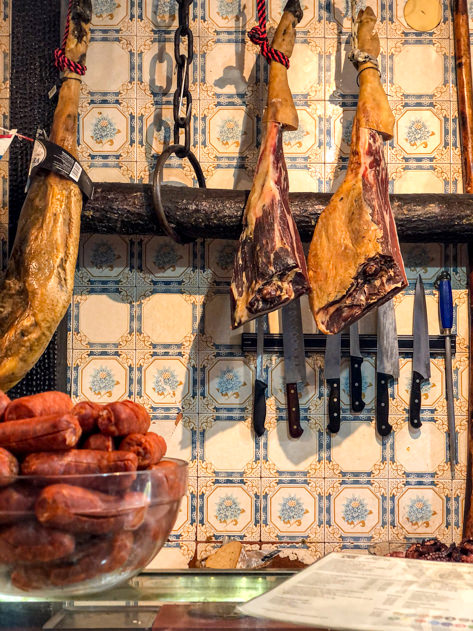
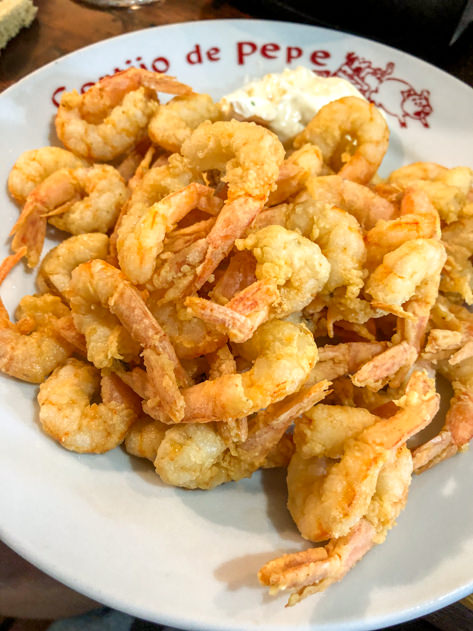
Traditional food from Málaga
As a city by the Mediterranean Sea, fish is the go-to food in Málaga, particularly deep-fried fish (pescaíto frito).
When walking along the boardwalks, you will notice plenty of beach bars and seaside restaurants (known as ‘chiringuitos‘) grilling various types of fish. The most popular dish is fresh sardines (‘espetos de sardinas‘), which are skewered and grilled, usually inside traditional fishing boats full of sand, only seasoned with a bit of olive oil and sea salt. Order a cold beer, enjoy and thank me later! 🙂
Other typical dishes you can sample in Málaga and around the province include: ajoblanco (a cold soup made of garlic and almonds served with grapes), berza malagueña (a stew consisting of vegetables and meat), gazpachuelo malagueño (a fish soup), or porra antequerana (a thicker variation of the traditional gazpacho and salmorejo that is also served cold).
The last thing you can’t miss when visiting Málaga is experiencing ‘tapeo‘, that is trying tapas, which are snacks that can be either served cold or hot, and can be combined to make a full meal.

Best bars and restaurants in Malaga
The city of Málaga offers a wide range of bars, cafeterias and restaurants where locals and visitors alike can taste its delicious cuisine. Based on my visits, below you will find my tried-and-tested recommendations:
- Bodega Bar El Pimpi: iconic wine cellar (bodega) next to the Picasso Museum and the Alcazaba with celebrity pictures, old barrels and a myriad of dining rooms. This is a true gateway to the gastronomic and cultural history of Malaga, offering tapas, seasonal products and local wines. The recently opened La Sole del Pimpi serves a fusion of Japanese and Mediterranean food.
- Chiringuito El Cachalote: try the delicious espetos of sardines and any kind of fresh fish in this beach bar located right on the Malagueta beach.
- Cortijo de Pepe: serving simple yet traditional food, enjoy some tapas at the bar or a proper meal at the tavern. When we visited, we ordered various tapas to share, including ensaladilla rusa (Russian salad), flamenquín casero (breaded ham and cheese, then fried), pincho moruno (kebab) and gambas fritas (fried prawns). The char-grilled chorizo de Ardales looked yummy too, although we didn’t get to try it.
- El Balneario de los Baños del Carmen: located right by Pedregalejo beach, this unique restaurant features a wonderful terrace overlooking the Mediterranean, in which you can enjoy traditional food.
- Mercado Central de Atarazanas: there’s nothing quite like visiting a local market to immerse yourself in the atmosphere of a city. Did you know this was actually a former Moorish shipyard? Open from 8am until 3pm from Monday to Saturday, I highly recommend wandering around the numerous market stands to buy fresh products ranging from fruits and vegetables, to fish and seafood. You can also experience it the way locals do by ordering tapas, either by the bar or sitting on a terrace.
- Los Mellizos: this restaurant chain specializes in fresh fish and seafood. They own two locations in the city of Málaga (in the Soho district and near Paseo del Parque), in addition to several others throughout the province, including in Benalmádena, Fuengirola, Marbella or Torremolinos.
- Lucciano’s: mouthwatering Italian ice creams in this imposing store. I chose the hazelnut flavored one (nocciola).
- Restaurante Orgánico Málaga – Tapería Orgánica Astrid: tapas bar serving organic products through a healthy, ecological cuisine. I eyed this place during my last visit, and definitely putting it on my bucket list for the next trip.
- Restaurante Vicen-Playa: located right in Playa de la Misericordia in eastern Málaga, we ate the following: a sardine and shrimp skewer, shrimp pancakes, and grilled red mullets.
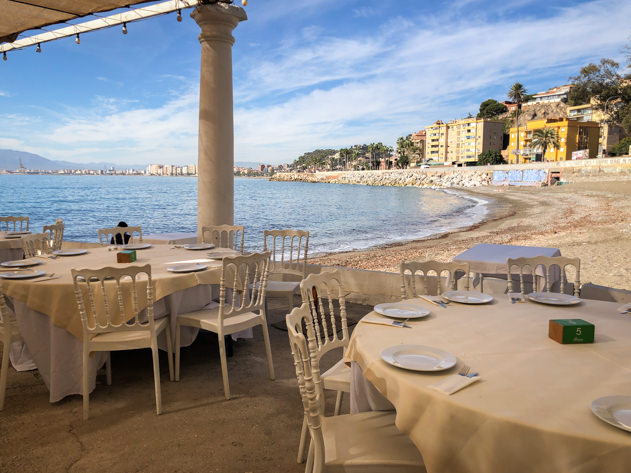
Other local recommendations to eat a bite in Málaga are Café de París, Centro Escuela de Hostelería de Málaga, El Café de Chinitas, El Merendero de Antonio Martín, or José Carlos García Restaurante. If you’re looking for tapas by the beach, head towards the myriad of beach bars known as chiringuitos along La Malagueta, Pedregalejo or El Palo.
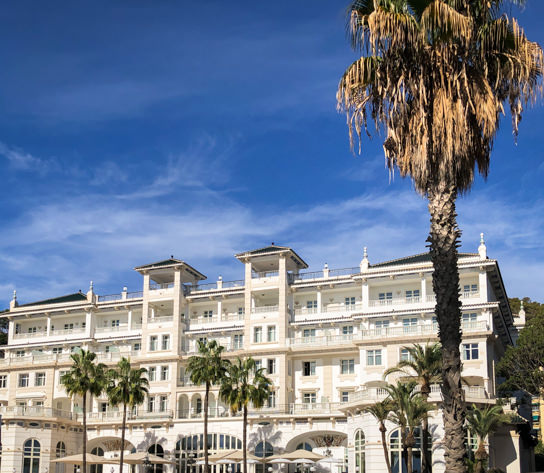
Where to stay in Málaga
Looking for the best hotels in Malaga? Below I have listed some suggested recommendations depending on your budget.
- Low budget: The Lights Hostel & Rooms, Hotel ibis Malaga Centro Ciudad, Hotel California
- Intermediate budget range: Atarazanas Málaga Boutique Hotel, Hotel Soho Boutique Bahía Málaga, Hotel Larios
- Luxury budget: Gran Hotel Miramar GL, Parador de Málaga Gibralfaro, AC Hotel by Marriott Malaga Palacio
You can browse additional options on Airbnb or Booking.
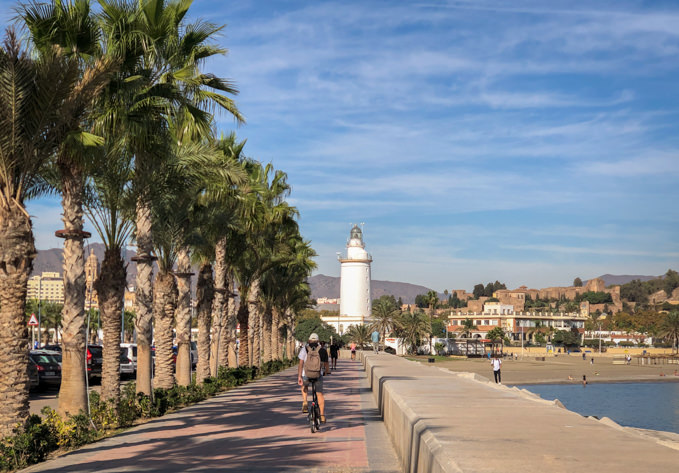
How to get around Málaga
As the capital of the Costa del Sol, the city of Málaga is a great base to explore the surrounding area, be they coastal towns or villages up in the mountains.
Besides, Malaga is well connected both domestically and internationally. Flamenco, nice weather and delicious food are some of the many reasons why tourists flock to this destination all year round. You can easily get around by foot or by horse-drawn carriage as in other cities of southern Spain such as Sevilla.
Let’s now turn to the various ways to reach Málaga in southern Spain.
🚲 By bike
Riding a bike is another great way to explore the capital city of Málaga as well as the nearby towns and villages. It has also become quite popular!
For example, you can easily reach the coastal city of Malaga from El Rincón de la Victoria in an hour thanks to the bike lanes running along the coast.
There are a number of companies renting bikes in Málaga such as Bike Tours Malaga, Malaga Bike Tours or Urban Bicycles by Prima.
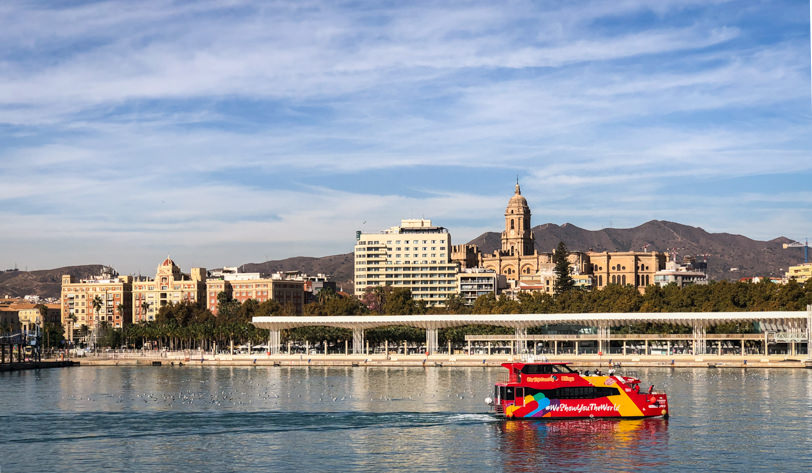
🛳️ By boat from the port and ferry terminal
The modern seaport (Puerto de Málaga) lies in the southern part of the city, not far from the Old Town. It is actually the oldest continuously-operated port in Spain and one of the earliest in the Mediterranean (others include Byblos, Cádiz, Marseille or Piraeus).
Both large ships and imposing cruises are welcomed into the port of Málaga, with ferry traffic having skyrocketed in recent years.
Another attraction in the port area is the white lighthouse known as La Farola, which was built in the 19th century.
Smaller boats can head to the nearby marinas (Real Club El Candado or Real Club Mediterráneo).
You can also buy a ticket for a boat tour to sightsee the city of Málaga from the water.
🚙 By car
If you’re driving to Málaga, you will find the city is well connected and offers plenty of parking too.
One of the major roads reaching Malaga is Autovía A-7, also known as Autovia del Mediterráneo. With more than 1,300 kms long, this toll-free limited-access highway runs along the Mediterranean Sea from La Junquera in Cataluña all the way to Algeciras in Cádiz.
In case you want to reach other destinations inland, you can drive on A-92 towards Almería, Granada, and Sevilla, or A-45 should you be heading to Córdoba.
🚇 By metro
Last but not least, the city of Málaga features its own metro. The network includes two lines linking the city center to the suburbs. Feel free to browse the map, tickets and fares for further information about Malaga’s subway.
✈️ By plane from the international airport
The Málaga-Costa del Sol Airport (Aeropuerto de Málaga – Costa del Sol) is located only 8 kms away from the city.
Looking for flights to Málaga? As a major tourism hub, you will find many airlines flying in and out of the city from this international airport that serves this area of Andalucía.
🚆🚌 By train or bus
Getting to Malaga by train is one of the best options for visitors. From the main station (Málaga María Zambrano) you can catch a high speed train known as AVE connecting you with other major Spanish cities such as Córdoba, Sevilla, Madrid or Barcelona in no time. Furthermore, you can also travel by train from Málaga to other towns on the Costa del Sol, such as Benalmádena, Fuengirola or Torremolinos.
The bus station (Estación de Autobuses de Málaga) lies next to the train station. Both of them are located just one kilometer away from the Malaga’s main commercial street (Calle Larios).
Day trips from Málaga, Spain
In case you feel like exploring beyond the capital city of Málaga, the options are plentiful either if you head inland or along the coast. Actually, Málaga is the gateway to the scenic Costa del Sol!
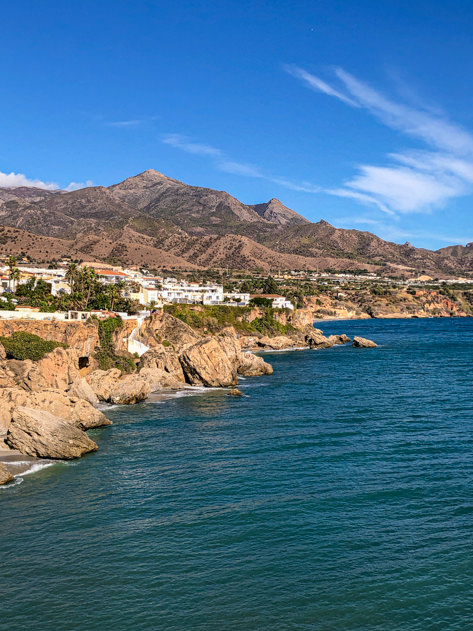
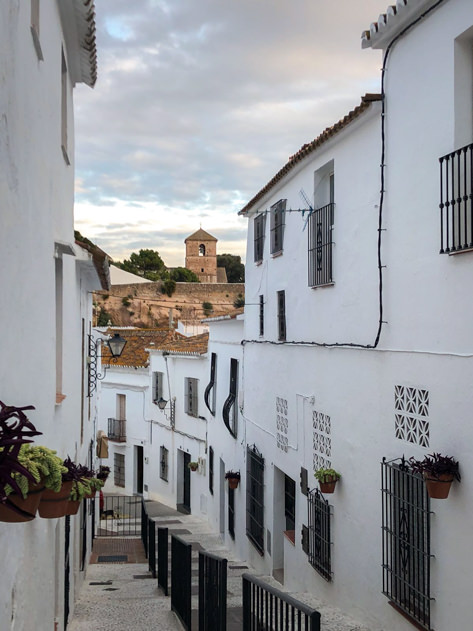
Here are six ideas of places you can explore near Malaga:
- Antequera (57 kms from Málaga): located at a crossroads, the city features large religious and civil buildings, including a Moorish Alcazaba, that make it one of the most monumental cities in Spain. Around Antequera you can also visit two natural sites worth mentioning: El Torcal, an impressive karst massif, and a set of three grandiose prehistoric dolmens (El Romeral, Menga, Viera).
- Frigiliana (67 kms from Málaga): this is one of the most beautiful white villages, not only in the Axarquía region, but also in the province of Málaga. Frigiliana has preserved its original Muslim layout, and the ruins of the Arab castle known as Lizar still dominate this municipality. The Manrique de Lara palace from the 16th century is also worth mentioning, given it’s the only cane honey factory that remains in Europe to this day.
- Marbella (60 kms from Málaga): often associated with the rich and famous from the jet set, it became a tourist hotspot in the fifties thanks to its sandy beaches, classy housing developments, and abundant golf courses. When visiting Marbella, make sure to stop at Plaza de los Naranjos, the Cathedral in the Old Town and to stroll along the promenade.
- Mijas (33 kms from Málaga): stereotypical white village featuring narrow and steep streets. Strategically located on a hill, it can be divided in two sections: Mijas Pueblo and Mijas Costa, next to the coastline. Their taxi donkeys (burros-taxi) are legendary, transporting passengers around.
- Nerja (66 kms from Malaga): located on a cliff, you can enjoy scenic views of the coastline from its promenades (Balcón de Europa or Paseo de los Carabineros). This coastal town also features golden beaches such as Playa de Burriana and a prehistoric cave (Cueva de Nerja).
- Ronda (101 kms from Málaga): it is the capital of the western interior of Malaga. This historic town is located at the top of a plateau crossed by a grandiose bridge (Puente Nuevo) over a dizzying gorge known as ‘tajo‘.
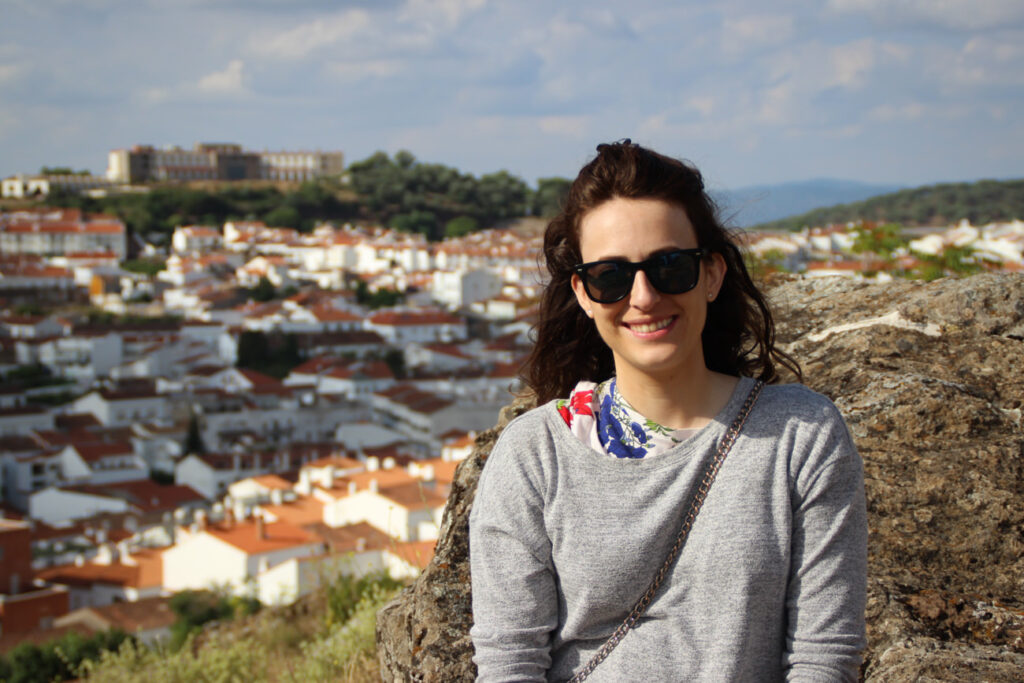
Read these posts for more inspiration around Andalucía!
Map with all the things to do in Málaga
Check out this map with all the locations mentioned throughout this post. Feel free to save it for later reference in case you’re planning a trip to Malaga!
How did you like this post featuring the top things to do in Málaga, from what to see and eat, to where to stay? I trust it inspired you to visit this wonderful Spanish city on Costa del Sol. Please drop me a line in case you have any comments or questions.
***
✈️ Curious to know where I’ll be traveling next? ✈️
Stay tuned by following me on social media (Facebook, Instagram, X) and subscribe to my newsletter for regular updates!
In the meantime, safe travels around the world!
***
| GET READY FOR YOUR NEXT TRIP! |
|---|
| Browse my travel resources page to plan your upcoming trip. |
| Feeling adventurous? Book any outdoor activities worldwide with Manawa! |
| Get medical or health insurance via SafetyWing for extra peace of mind. |
| Looking for sports equipment? Feel free to browse my Decathlon profile for inspiration. |
| Use the Anaya Touring or Lonely Planet travel guidebooks to plan your trip. They’re really comprehensive and helpful! |
| Create travel memories you’ll never forget! Book things to do, attractions and tours around the world with Get Your Guide. |
| Use your Revolut Card to pay in local currency when you’re traveling abroad! |

